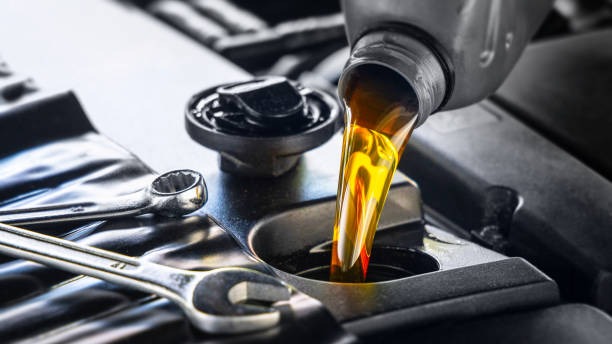Regular vehicle maintenance goes beyond appearances—fluids play a vital role in keeping your car running smoothly by lubricating, cooling, and supporting its components. Many drivers overlook fluid upkeep until issues arise, but understanding common automotive fluids, their purpose, and when to replace them is essential for avoiding costly repairs.
The Most Common Car Fluids and Their Functions
Your vehicle relies on a surprisingly diverse lineup of fluids. Here are the main players and what each brings to the table:
1. Engine Oil
Function
Engine oil keeps your engine running smoothly by lubricating moving parts, reducing heat, fighting corrosion, and carrying away impurities.
When to Replace
Most automakers recommend changing conventional oil every 3,000 to 5,000 miles and synthetic oil every 7,500 to 10,000 miles—but always check your owner’s manual.
Signs It’s Time
- Oil appears dark and gritty
- Engine runs noisier than usual
- Oil change or check engine light is on
2. Transmission Fluid
Function
This vital fluid lubricates the moving parts inside your transmission and acts as a coolant, especially critical for automatic transmissions.
When to Replace
For automatic transmissions, intervals range from 30,000 to 60,000 miles, while some new vehicles have “lifetime” fluids that still benefit from periodic change. Manual transmissions may use gear oil with different intervals. Always stick with manufacturer guidelines.
Signs It’s Time
- Slipping gears
- Delayed shifting
- Dark, burnt-smelling fluid
3. Coolant (Antifreeze)
Function
Coolant circulates through your engine and radiator, maintaining an optimal temperature and preventing overheating or freezing in extreme conditions.
When to Replace
Typically every 2 to 5 years or 30,000 to 60,000 miles. Coolant types and intervals can vary, so refer to your owner’s manual.
Signs It’s Time
- Overheating engine
- Sweet smell or colored fluid under the car
- Coolant level drops frequently
4. Brake Fluid
Function
Brake fluid is a hydraulic fluid that allows force from your foot to be transmitted to the brakes, enabling safe stops.
When to Replace
Most manufacturers recommend changing brake fluid every 2 years. Wet climates or heavy braking can necessitate more frequent changes.
Signs It’s Time
- Spongy or unresponsive brakes
- Warning light on dashboard
- Dirty or dark fluid in the reservoir
5. Power Steering Fluid
Function
This fluid makes steering less laborious by providing hydraulic assistance to the steering system.
When to Replace
Refer to your vehicle’s schedule, but many recommend changing every 50,000 miles or as needed.
Signs It’s Time
- Difficult or noisy steering
- Low fluid in the reservoir
- Leaking fluid under the front of the car
6. Windshield Washer Fluid
Function
Washer fluid helps clear your windshield of dirt, bugs, and grime, keeping your visibility uncompromised.
When to Replace
There’s no set interval; refill as needed, especially before long trips or seasonal changes.
Signs It’s Time
- Weak spray or no spray
- Reservoir appears empty
7. Differential and Transfer Case Fluids
Function
Found in vehicles with all-wheel or four-wheel drive, these specialized fluids lubricate the gears and bearings in the differential and transfer case.
When to Replace
Intervals vary widely (often every 30,000 to 60,000 miles), so consult your owner’s manual.
Signs It’s Time
- Unusual noise from under the vehicle while turning
- Difficulty engaging all-wheel or four-wheel drive
Why Fluid Maintenance Matters
Neglecting fluid replacement isn’t just rough on your wallet; it can lead to catastrophic systems failures and unsafe driving conditions. Here’s why regular checks and timely replacements are critical:
- Performance: Fresh fluids ensure systems operate at peak efficiency and responsiveness.
- Longevity: Timely replacements minimize internal wear, extending the lifespan of engine and transmission components.
- Safety: Proper fluid levels and quality are essential for safe braking, steering, and temperature regulation.
- Preventive Care: Regular fluid checks help detect early signs of leaks or component wear before they become costly repairs.
How to Check and Maintain Your Fluid Levels
- Read Your Manual: Your owner’s manual is a goldmine for specific recommendations.
- Do Monthly Checks: Make it a habit to inspect fluid levels and conditions at least monthly.
- Watch for Leaks: Check under your car for puddles or unusual smells.
- Mind the Color and Smell: Fluids that are dark, cloudy, or have a burnt or unusual odor often need replacement.
When in Doubt, Ask a Professional
While many drivers can handle basic fluid checks and top-ups, some jobs, like an oil change, like those in Provo, Utah, are best left to trusted mechanics, especially when dealing with transmission, brake, or differential fluids. If you’re uncertain, don’t hesitate to ask for guidance.
Conclusion
Staying on top of your vehicle’s fluids is a simple habit that pays big dividends in performance, reliability, and safety. By knowing what each fluid does, when it needs attention, and how to spot signs of trouble, you can drive confidently and keep your car running smoothly for years to come.
Regular maintenance of your vehicle’s fluids is crucial for optimal performance and longevity. Among these, transmission fluid plays a vital role in ensuring smooth gear shifts and preventing overheating. For those driving a Ford F-250 Super Duty from 1999 to 2007, understanding the specific needs of your vehicle’s transmission is essential. You can find everything you need to know about 1999–2007 F-250 transmissions, including maintenance tips and replacement schedules, to keep your truck running smoothly. Keeping an eye on fluid levels and adhering to recommended service intervals can prevent costly repairs and extend the life of your vehicle.



